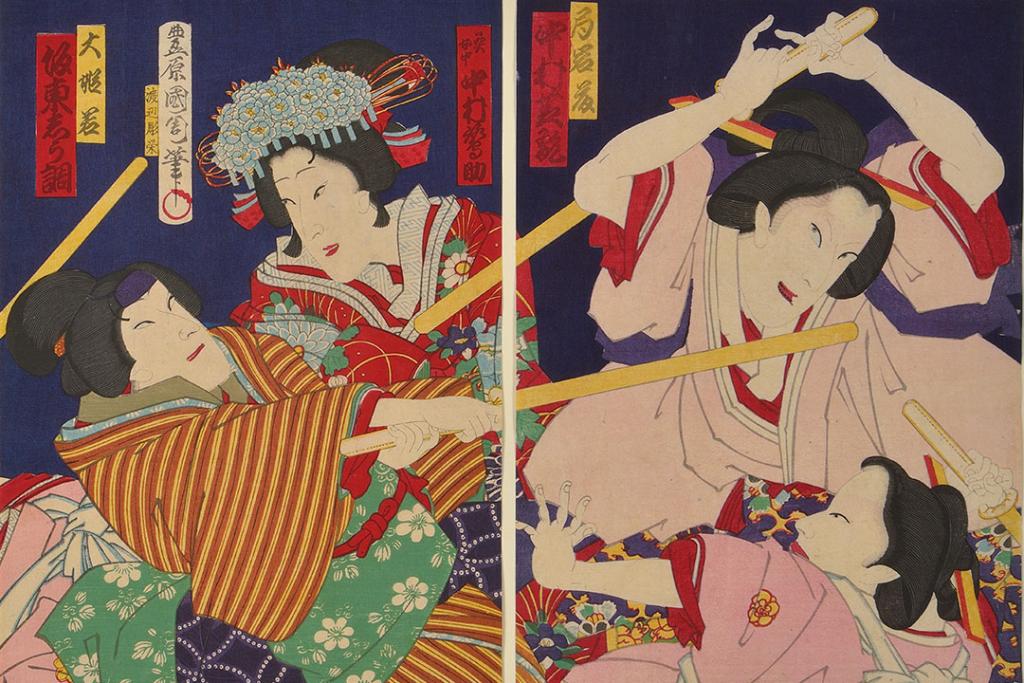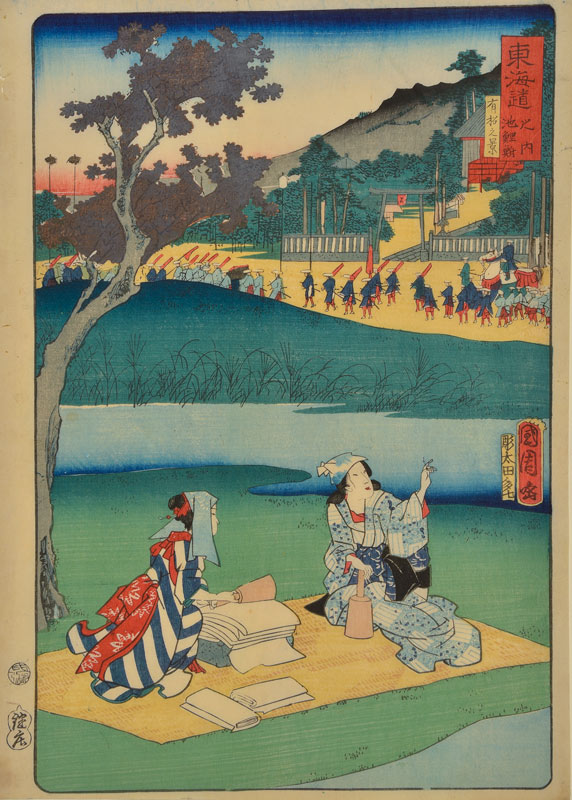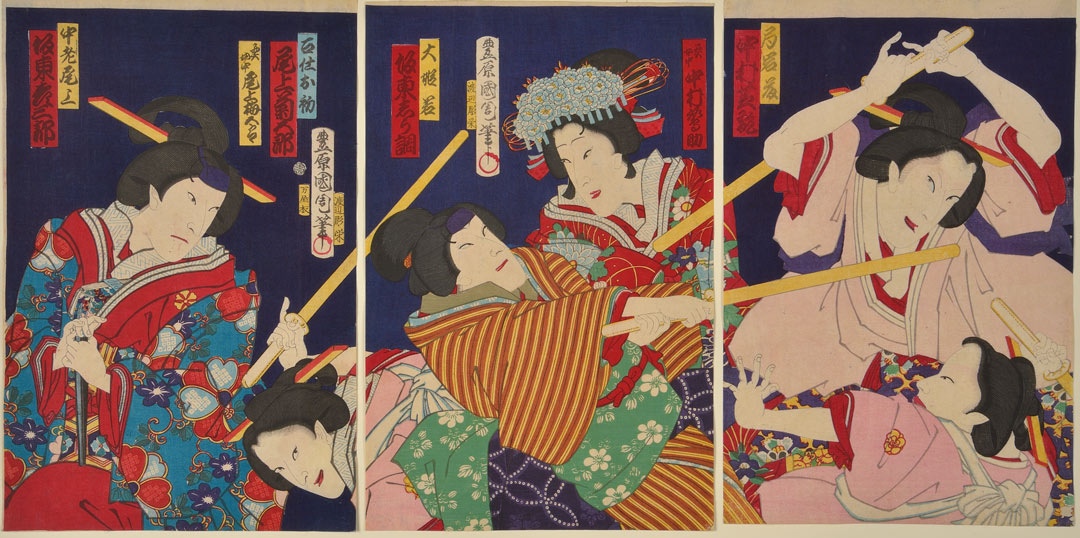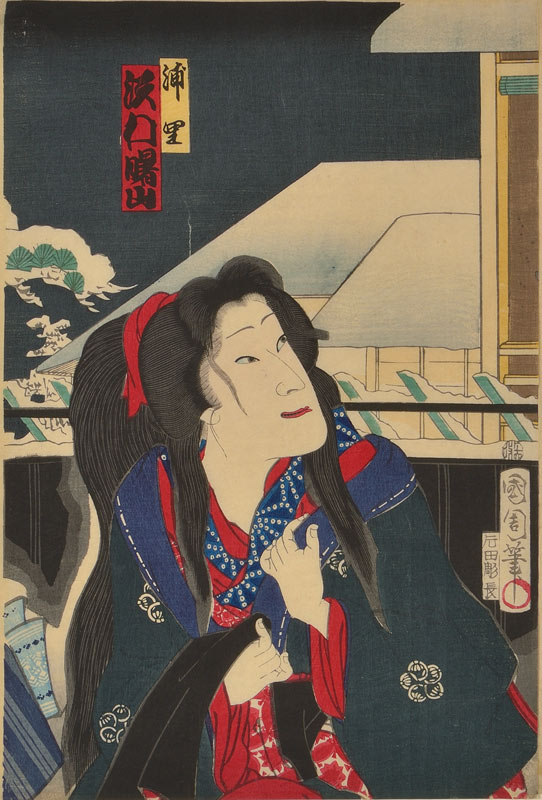The Real Women of Edo
Far from the traditional modest figures you might expect, the women depicted by Kunichika hint at a far more feisty side. Carla-Rosa takes a look at the changing roles of women in 19th century Japan and how this is reflected in Kunichika's prints, which document a time of great change and modernisation.

Japan was once a matriarchal society, but the introduction of Confucian ideals changed the power women had. Patriarchy and hierarchy were valued, and Japan was divided into a caste system: the ruling class, townsman class, and the peasant class. Each caste had ranks within it and there was an interdependent relationship between farmers, merchants and the dominant samurai. A hierarchy of sex workers had also developed in Japan, with very expensive ‘beauties’ at the top. The women were characteristically beautiful, with elaborate hair styles, make-up and clothing. They were considered the ideal female as they were also educated and compliant.
The Onna Daigaku (‘Learning for Women’) (1716) was prescribed reading for Japanese women. This manual emphasised the obedience of a daughter to her father, a wife to a husband, and a widow to her son. The sentiment of the text was eventually considered vague, especially around the notion of ‘womanly cultivation’. A replacement, the Kyōiku ni Kansuru Chokugo (‘Imperial Rescript on Education’), was thus introduced. Signed by Emperor Meiji in 1890, the book encouraged husbands and wives to ‘be harmonious’ with one another, and there is some debate about what this meant – did it indicate the woman’s submission to a man, or a genuine equality between them?

Alongside these principles for Japanese women to live by, ideal female beauty was portrayed in the popular prints known as bijin-ga. Kunichika and his contemporaries were inspired by the great bijin-ga artist Utamaro, whose prints showed women of different economical classes in a variety of settings. Mothers, young women, sex workers, teahouse workers, writers, and geishas all featured in the prints.
Kunichika’s prints were similar to Utamaro’s, but they incorporated a wider variety of women, and in more modern settings. Kunichika’s beauty series prints were popular throughout his career and contained between twelve and forty images in each series. His largest and perhaps most famous series of bijin prints, ‘The Thirty-six Good and Evil Beauties’, featured a range of women, both fictional and with elements of the real.
As well as his portrayals of actual Japanese women in his bijin-ga series, Kunichika captured how Japanese female characters were portrayed on the stage. Kabuki theatre was popular among women of all social positions in Japan. Japanese women were shown in the kabuki actor prints, but at the time, they were not allowed to act on stage. In kabuki theatre, all female roles were played by male actors known as onnagata. The female characters were often controversial and represented aspirational roles: women prepared to walk away from their duty to pursue a lover; women willing to burn down a building in order to see their lover; women ready to fight. These were bold and lively women, unlike the timid and modest personalities encouraged in real life. These women were deemed attractive for their bravado, regardless of their social rank.

Kabuki plays featured women as criminals and bandits, and women who murdered men - dokofu as they were called, or ‘poison women’. The latter featured the more stereotypical images of women, as ‘evil’ witches who devour foetuses, for example, and were born from this societal anxiety.
Another popular genre in which women were rarely portrayed, were the warrior prints. The strong, powerful and brave traits associated with warriors were considered to be a man’s domain. Kunichika’s warrior prints feature men acting as women - in ‘Onna Shiranami’ (featured in the exhibition), male kabuki actor Ichikawa Sadanji is in the role of a female thief. During the Meiji period, women’s status was improving, but there was some panic around their newfound freedom.
This gives an insight into the changing roles at the time, as well as the restrictions still placed upon Japanese women. In both the real and fictional realms, women were the target of idealised beauty and etiquette. Kunichika’s women seem to sit between the two; his characters are real, but at the same time they are imagined. They somewhat illustrate the period of change in Japan, especially for women, and the conflict this created.

All images © National Museums Liverpool, courtesy of Frank Milner
